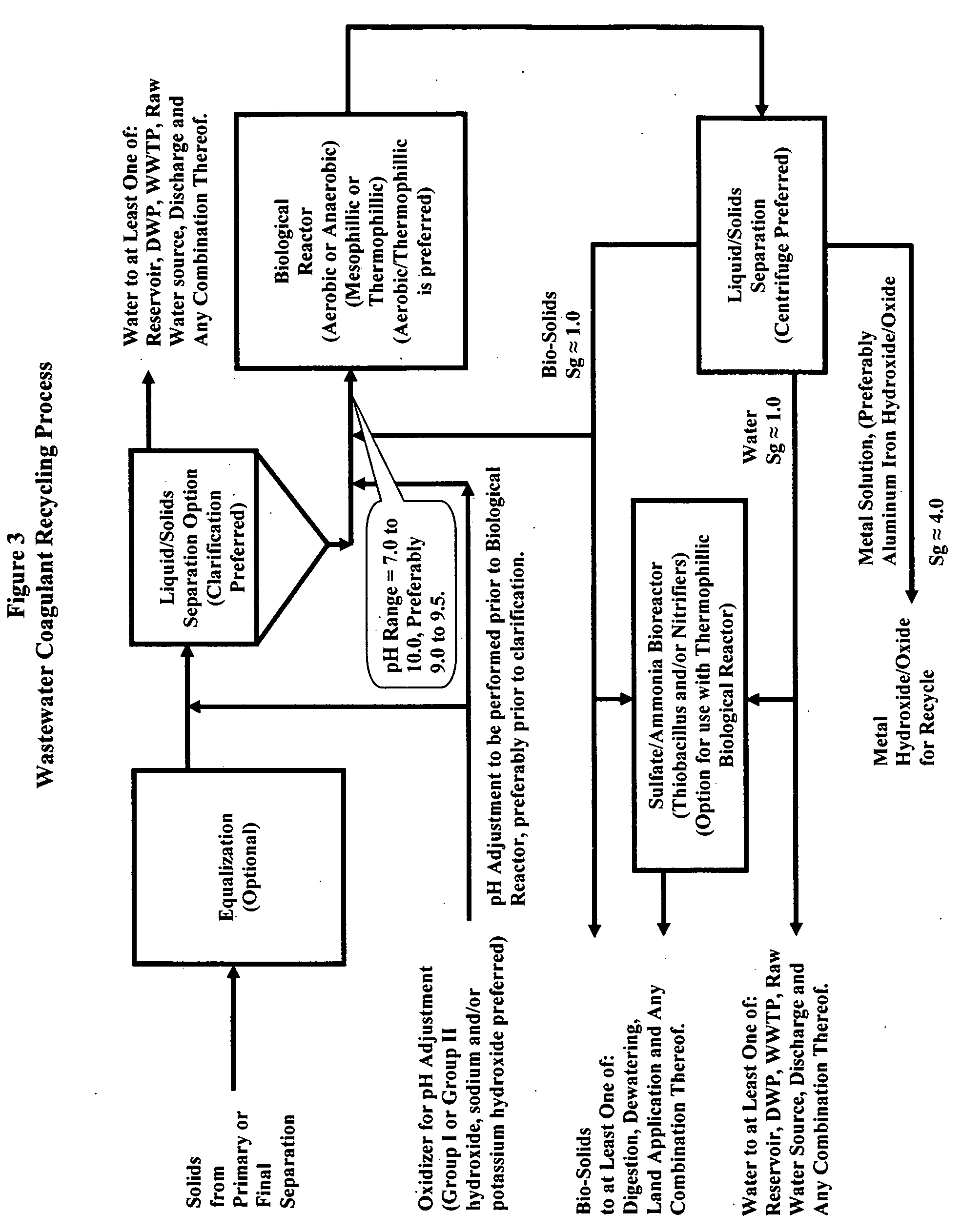Waste metals recycling-methods, processed and systems for the recycle of metals into coagulants
a technology of coagulant and metals, applied in the field of waste metals recycling methods, processed and systems for the recycling of metals into coagulants, can solve the problems of increased operation cost, considerable processing and transportation cost, and not common for drinking water facilities to have ss dewatering equipment. achieve the effect of efficient, economical and effective process
- Summary
- Abstract
- Description
- Claims
- Application Information
AI Technical Summary
Benefits of technology
Problems solved by technology
Method used
Image
Examples
example 1
[0047] The City of DeQueen, Ark. operates a municipal drinking water plant using aluminum chlorohydrate as the coagulant. Raw water alkalinity varies from near 10 to near 20 mg / L. Raw Water turbidity varies from near 6 to near 50 NTU with occasional spikes to near 80 NTU. This drinking water plant is of traditional design having a rapid mix, flocculation, clarification and filtration system. Waste aqueous solids, sludge from the clarifiers and filter backwash is sent to an evaporation pond prior to pond overflow into the municipal waste collection system which transports the sludge to the municipal wastewater treatment plant.
[0048] A 1 gallon sample of waste aqueous sludge was obtained, chilled and transported prior to testing.
[0049] 500 ml of the above sludge was placed into a 1 L beaker on a magnetic stir plate. The pH of the sludge was raised to near 9.25 with sodium hydroxide.
[0050] 1 gram of a dry blend of heterotrophs obtained from Envera, a Waste Water Treatment Product Bl...
example 2
[0052] The City of Nashville, Ark. operates a municipal drinking water plant using CV 1766 (a blend of aluminum chlorohydrate and CV 3650) as the coagulant. Raw water alkalinity varies from near 10 to near 30 mg / L. Raw Water turbidity varies from near 6 to near 40 NTU with occasional spikes to near 60 NTU. This drinking water plant is of traditional design having a rapid mix, flocculation, clarification and filtration system. Waste aqueous solids, sludge from the clarifiers and filter backwash is wasted to an evaporation pond.
[0053] A 1 gallon sample of waste aqueous sludge was obtained, chilled and transported prior to testing.
[0054] 500 ml of the above sludge was placed into a 1 L beaker on a magnetic stir plate. The pH of the sludge was raised to near 9.25 with sodium hydroxide.
[0055] 1 gram of a dry blend of heterotrophs obtained from Envera, a Waste Water Treatment Product Blend of Lot # 040906, were wetted for 1 hour with an air stone providing a DO concentration of near 3 ...
example 3
[0057] A sample of aluminum chloride, GPAC 2200 from Gulbrandsen Company, Inc., was placed into a 1 L beaker. The pH of the sample was raised to near 8.75 with sodium hydroxide creating a grayish / reddish liquid. Into the beaker was then placed near 1.5 ppm CV 6130 was added and mixed at high speed for near 30 seconds and then mixed at slow speed for near 5 minutes. A grayish / reddish floc developed and settled from a near clear water.
PUM
| Property | Measurement | Unit |
|---|---|---|
| temperature | aaaaa | aaaaa |
| temperatures | aaaaa | aaaaa |
| temperatures | aaaaa | aaaaa |
Abstract
Description
Claims
Application Information
 Login to View More
Login to View More - R&D
- Intellectual Property
- Life Sciences
- Materials
- Tech Scout
- Unparalleled Data Quality
- Higher Quality Content
- 60% Fewer Hallucinations
Browse by: Latest US Patents, China's latest patents, Technical Efficacy Thesaurus, Application Domain, Technology Topic, Popular Technical Reports.
© 2025 PatSnap. All rights reserved.Legal|Privacy policy|Modern Slavery Act Transparency Statement|Sitemap|About US| Contact US: help@patsnap.com



